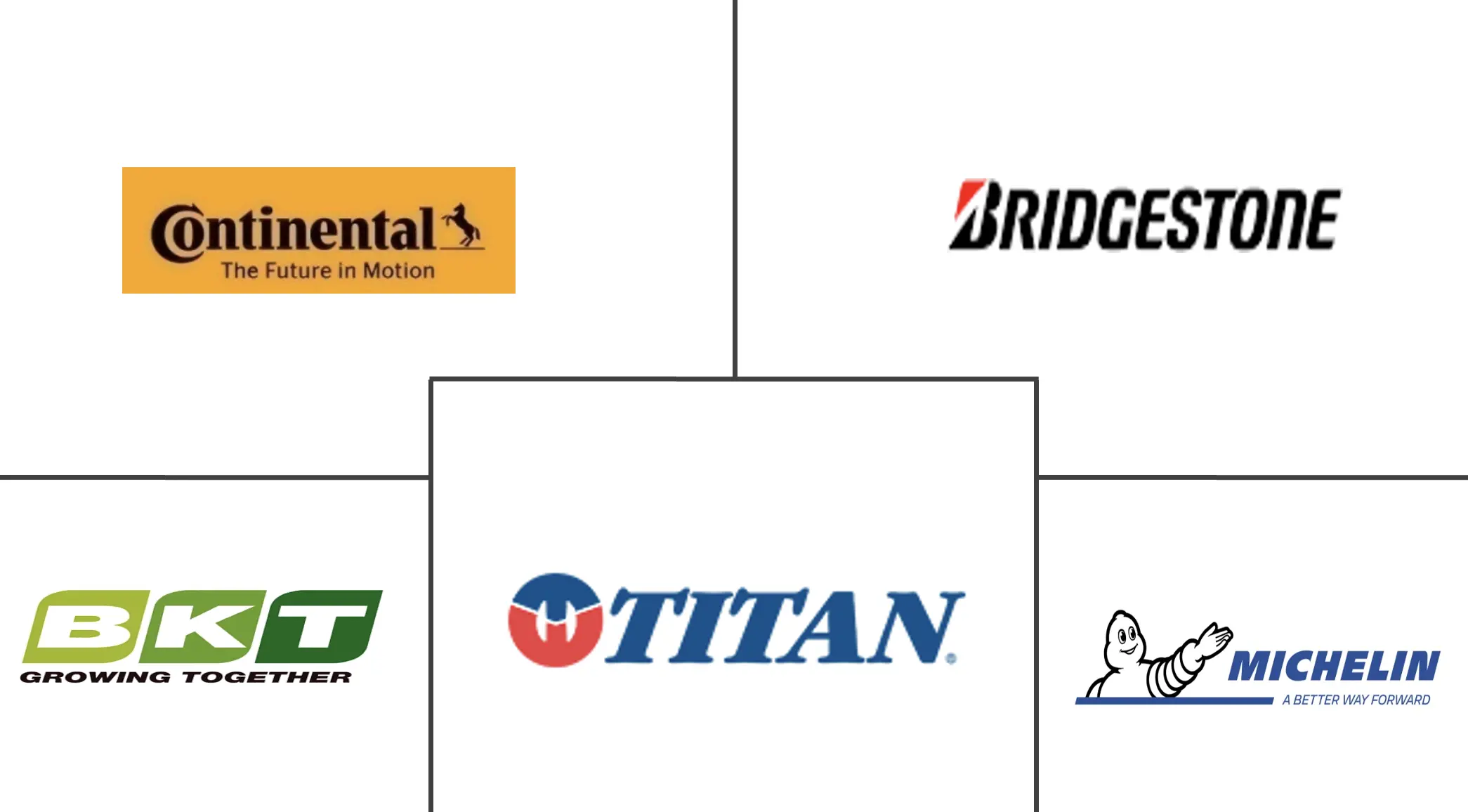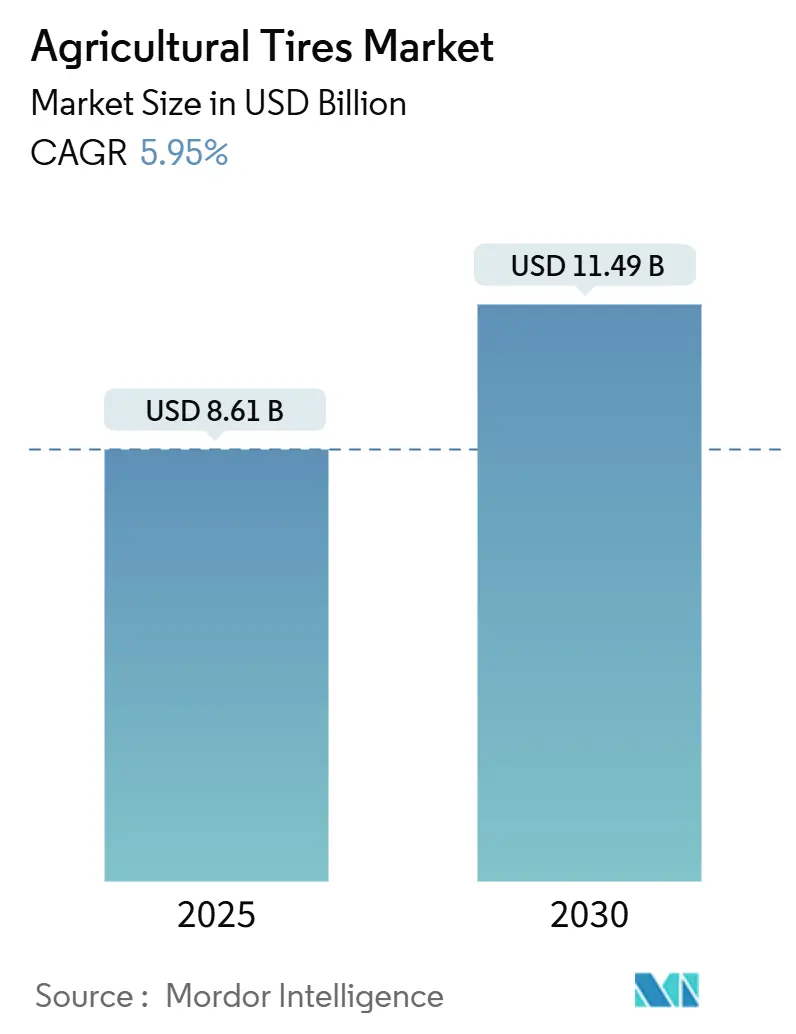
Agricultural Tires Market Analysis by Mordor Intelligence
The Agricultural Tires Market size is estimated at USD 8.61 billion in 2025, and is expected to reach USD 11.49 billion by 2030, at a CAGR of 5.95% during the forecast period (2025-2030). The Agricultural Tires market is benefiting from sustained mechanization demand, rapid radialization, and the commercialization of IF/VF technologies that improve load capacity while reducing soil compaction. Growth momentum is further reinforced by farmers’ steady shift toward precision farming, swelling replacement demand from aging tractor fleets, and a widening preference for Central Tire Inflation Systems that lower operating costs. Competitive intensity is mounting as incumbents and regional challengers upgrade product lines, invest in smart-tire platforms, and pursue vertical integration to mitigate raw-material price volatility. Supply-chain recalibration, particularly around natural rubber sources, remains an important theme shaping the Agricultural Tires market through 2030.
Key Report Takeaways
- By sales channel, the aftermarket commanded 71.29% of the Agricultural Tires market share in 2024, whereas OEM channels are advancing at a 5.97% CAGR through 2030.
- By application, tractors captured 56.73% of the Agricultural Tires market size in 2024; sprayers are forecast to expand at a 6.03% CAGR between 2025 and 2030.
- By tire construction, radial designs held 53.22% of the Agricultural Tires market in 2024, while IF/VF radials are the fastest-growing sub-segment at a 6.07% CAGR through 2030.
- By rim size, the 20–30 inch category led with 45.51% of the Agricultural Tires market share in 2024, More than 40 inch rims are projected to rise at a 6.12% CAGR through 2030.
- By horsepower class, the 30–70 HP class secured 41.28% of the Agricultural Tires market size in 2024, with more than 150 HP machinery progressing at a 6.17% CAGR to 2030.
- By inflation-tech compatibility, the standard tires secured 81.26% of the Agricultural Tires market size in 2024, with smart tires progressing at a 6.23% CAGR to 2030.
- By geography, Asia Pacific secured 37.83% of the Agricultural Tires market size in 2024, with South America progressing at a 6.21% CAGR to 2030.
Global Agricultural Tires Market Trends and Insights
Drivers Impact Analysis
| Driver | (~) % Impact on CAGR Forecast | Geographic Relevance | Impact Timeline |
|---|---|---|---|
| Rapid Mechanization And Fleet Renewal | +1.8% | Asia-Pacific core, spill-over to South America and Middle East and Africa | Medium term (2-4 years) |
| Shift From Bias To Radial | +1.5% | North America and EU leading, expanding to emerging markets | Medium term (2-4 years) |
| Growing Global Population | +1.2% | Global, with highest impact in Asia-Pacific and Africa | Long term (≥ 4 years) |
| Surging Replacement Demand | +0.9% | Global, concentrated in mature markets | Short term (≤ 2 years) |
| Real-Time Tire-Pressure | +0.8% | Europe and North America, expanding to Asia-Pacific | Medium term (2-4 years) |
| EU-Ukraine Reconstruction | +0.6% | Europe, with secondary effects in neighboring regions | Short term (≤ 2 years) |
| Source: Mordor Intelligence | |||
Rapid Mechanization & Fleet Renewal In Emerging Markets
Emerging economies are in the midst of pronounced fleet modernization. Argentina anticipates growth in tractor, harvesters, and sprayers sales during 2025, underpinned by policy-backed financing and local-content incentives that reduce import-cost exposure. Rising preference for 30–70 HP machines underscores opportunities for specialized mid-range tires, while >150 HP equipment accelerates the push toward VF specifications. Industry participants including Case IH are expanding Asian footprints, highlighting the magnetic pull of high-growth markets despite infrastructure bottlenecks such as limited rural internet. These dynamics collectively bolster the Agricultural Tires market outlook.
Shift From Bias To Radial / If-Vf Low-Compaction Tires
The cost-benefit rationale for radialization is compelling: IF designs allow one-fifth higher load at identical pressure, and VF designs expand the margin to two-fifth[1]“2024 Yearbook,” Tire and Rim Association, ustma.org . Michelin’s CEREXBIB 2 line for New Holland’s CR11 combine, accommodating 19 ton loads with a wider footprint, illustrates manufacturers’ commitment to soil preservation. Standards codified by the Tire & Rim Association have harmonized inflation protocols, accelerating global adoption. Expedited product launches from BKT, CEAT, and Yokohama further diversify VF offerings across both OEM and replacement channels. As more farms prioritize fuel efficiency and soil health, the Agricultural Tires market is witnessing rapid technology diffusion from bias to advanced radial products.
Growing Global Population & Food-Security Pressure
Sustained population growth is raising food-security imperatives that amplify mechanization spending across developing economies. In 2024, China and India together accounted for more than two-fifth of global agricultural equipment growth, catalyzing fresh demand across the Agricultural Tires market. Precision-agriculture tools such as satellite monitoring and AI-driven crop advisory platforms are becoming basic requisites, encouraging farmers to invest in tires capable of supporting heavier, digitally enabled machinery. Public-policy frameworks that subsidize equipment upgrades—especially throughout Asia-Pacific—strengthen this trajectory. In markets where arable land per capita is tightening, low-compaction VF tires provide a tangible path to boosting yields without expanding acreage. As food-security concerns remain a structural driver, the Agricultural Tires market is expected to maintain a firm growth course through the next decade.
Surging Replacement Demand From Aging Tractor Fleet
Even when new-equipment orders soften, replacement tires maintain firm momentum. In the United States, aftermarket agricultural tire sales remained stable in 2024 despite weaker machinery deliveries, as farmers opted to refurbish rather than replace existing tractors. BKT USA recorded strong growth in first-half 2024 agricultural sales, largely driven by VF and IF tire retrofits for midlife machinery. Premium replacement tiers also offer brand-owners stronger margins, incentivizing manufacturers to push technology upgrades—such as improved tread compounds and CTIS-ready casings—to the aftermarket. This resilient segment underpins stable cash flows and supports continuous R&D investment across the Agricultural Tires industry.
Restraints Impact Analysis
| Restraint | (~) % Impact on CAGR Forecast | Geographic Relevance | Impact Timeline |
|---|---|---|---|
| Fluctuating Agricultural Commodity Prices | -1.1% | Global, with highest volatility in emerging markets | Short term (≤ 2 years) |
| Natural-Rubber And Petrochemical Cost Volatility | -0.8% | Global, with manufacturing concentrated in Asia | Medium term (2-4 years) |
| Supplier Exits Limiting Choice | -0.6% | Global, with concentrated impact in specialized segments | Medium term (2-4 years) |
| Rubber-Leaf Disease Constraining Raw-Material Supply | -0.4% | Southeast Asia core, spill-over to global supply chains | Long term (≥ 4 years) |
| Source: Mordor Intelligence | |||
Fluctuating Agricultural Commodity Prices
Commodity price cycles shape farmers’ capital-spending capacity. Brazil’s agricultural machinery sales fell slightly in 2024 to close to half a lakh units amid a uptick Selic rate that inflated borrowing costs[2]“Agricultural Machinery Sales 2024,” Brazilian Institute of Geography and Statistics, ibge.gov.br . Argentina’s equipment registrations showed early-2025 month-on-month declines despite annual improvements, underlining persistent caution. When cash flows tighten, OEM demand softens and factory scheduling becomes erratic, challenging tire suppliers. Conversely, replacement needs remain steadier, cushioning revenue dips. This dichotomy reinforces why the aftermarket anchors baseline demand across the Agricultural Tires market.
Natural-Rubber & Petrochemical Cost Volatility
Natural-rubber prices hit 18,845 yuan per tonne in early 2025 as weather-related supply disruptions and geopolitical uncertainty unsettled global inventory balances. Synthetic rubber and carbon-black feedstocks faced logistics snarls linked to the Ukraine conflict, prompting manufacturers to revisit just-in-time policies. Industry leaders are diversifying sourcing, investing in guayule research, and increasing local compounding to mitigate transport risks. These measures help buffer profitability but could raise capital requirements, influencing pricing strategies and strategic sourcing across the Agricultural Tires market.
Segment Analysis
By Sales Channel: Aftermarket Dominance Drives Steady Growth
The Agricultural Tires market size attributed to the aftermarket accounts for 71.29% of market share in 2024. Farmers’ strong inclination to extend equipment lifespan, particularly during high interest-rate periods, reinforces this dominance. OEM channels are on a 5.97% CAGR path through 2030, buoyed by Ukraine reconstruction and policy-supported fleet renewal in Latin America.
Bridgestone’s August 2024 U.S. introduction of VX-TRACTOR, VT-TRACTOR, and VX-R TRACTOR portfolios illustrates the pursuit of premiumization, promising longer wear life and 40% higher load capacity. Parallel OEM momentum stems from Trelleborg’s agreement with John Deere, granting access to more than 300 Brazilian dealerships and positioning CTIS-ready tires for new tractor deliveries. The interplay between defensive aftermarket strength and revitalized OEM orders underscores balanced growth drivers across the Agricultural Tires market.
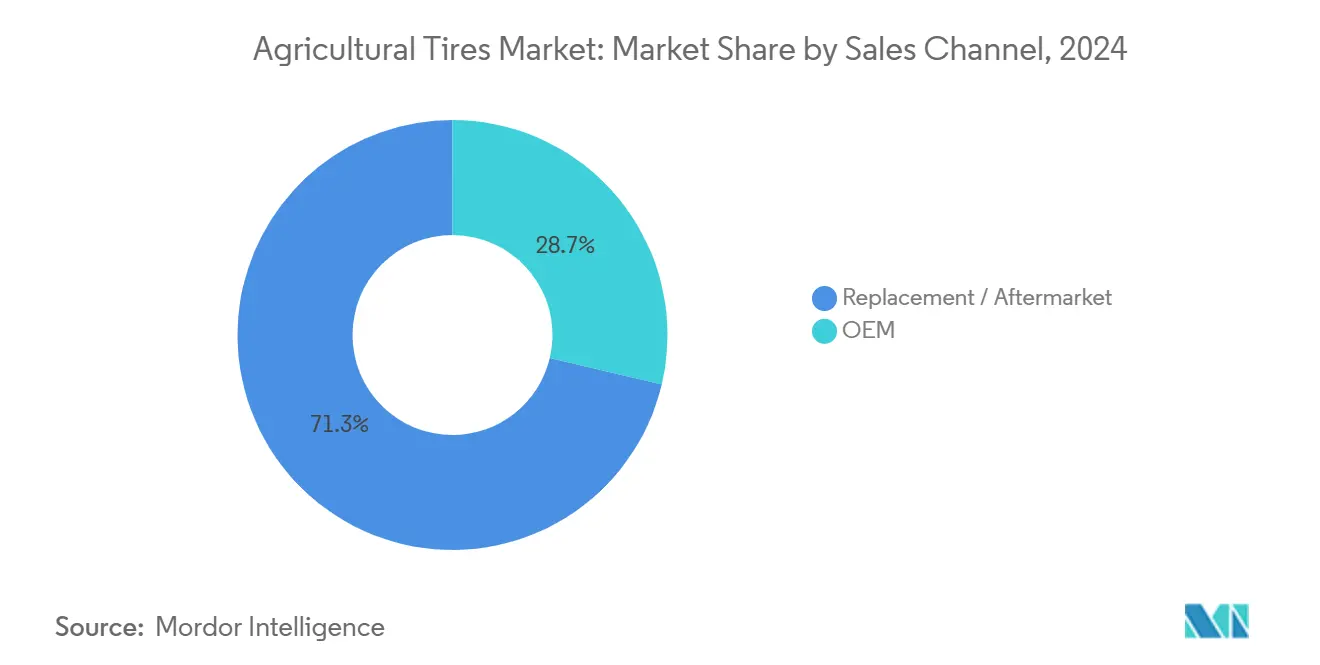
By Application: Tractors Lead While Sprayers Accelerate
Tractors generated 56.73% of the Agricultural Tires market in 2024, cementing their centrality in daily farm tasks. Sprayers, although representing a smaller base, are forecast for 6.03% CAGR through 2030, sharpening demand for narrow-section VF tires compatible with high-clearance machinery. Combine harvesters and trailers capture residual shares yet set distinct performance benchmarks that shape tread design and carcass rigidity.
Apollo’s Vredestein Traxion CropCare series grants 30% higher lateral stability for sprayers, reflecting an engineering push tailored to crop-protection equipment. Michelin’s VF 900/65R46 CFO tire, boasting a 2.32 m diameter and 19 ton load rating for New Holland’s CR11 harvester, mirrors a trend toward oversized, heavy-duty solutions. These innovations broaden performance envelopes and enlarge the value proposition of the Agricultural Tires market.
By Tire Construction: Radial Dominance With IF/VF Innovation
Radial designs accounted for 53.22% of the Agricultural Tires market share in 2024, crystallizing their mainstream status. Bias tires still serve niche cost-sensitive requirements but continue to lose ground. IF/VF radials, with a 6.07% CAGR, illustrate the apex of innovation as farmers quantify yield uplift and fuel savings.
Yokohama’s Alliance Agriflex+ 377 XT, integrating VF sidewalls and Cyclical Field Operation technology to boost load capacity by more than half during repetitive cycles, typifies performance leaps. Bridgestone’s Firestone Ag Regency Plus bias range sustains relevance in utility niches, offering nearly 100 SKUs with five-year warranties. This pluralistic landscape allows the Agricultural Tires market to satisfy divergent budget and performance preferences.
By Rim-Size: Mid-Range Leadership With Large-Size Growth
Rims between 20 inch and 30 inch constituted 45.51% of the Agricultural Tires market in 2024, mirroring the prevalence of mid-range tractors. Segments above 40 inch will climb at 6.12% CAGR to 2030 as horsepower escalation and flotation needs intensify. Smaller categories cater to compact equipment and regional cropping methods.
Mitas’ VF 1000/65R32 CFO offers heightened load ratings without pressure compromises, ensuring soil-friendly operation for large combines. Linglong’s Agri Master lineup spanning 420/85R28 to 460/85R38 sizes reiterates commitment to the dominant 20–30 inch class. Collectively, rim-size diversification sustains flexibility within the Agricultural Tires market.
By Equipment Horse-Power Class: Mid-Range Dominance with High-Power Growth
The 30–70 HP bracket delivered 41.28% of the Agricultural Tires market share in 2024 and remains the operational backbone of small to mid-scale farms. Equipment exceeding 150 HP will expand at a 6.17% CAGR, riding on large-farm consolidation and precision agriculture. Under-30 HP and 71–150 HP segments fulfill region-specific agronomic practices yet register slower trajectories.
Titan International’s Low Sidewall (LSW) solutions enhance ride quality on high-horsepower machines, addressing soil-contact pressures and lateral sway. Bridgestone’s VX-R TRACTOR targets 30–70 HP users with a balanced focus on traction, durability, and fuel economy. This spectrum of horsepower-tailored offerings enriches value creation across the Agricultural Tires market.
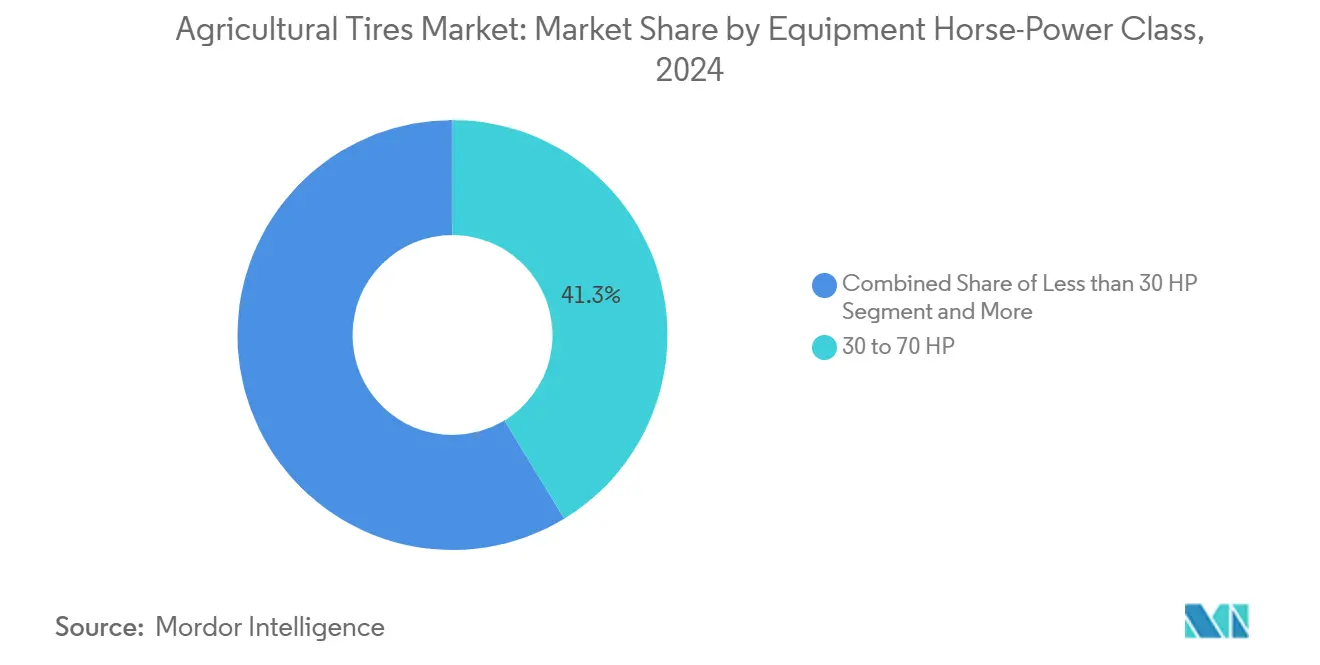
By Inflation-Technology Compatibility: Standard Tires Lead with Smart Technology Growth
Conventional casings still dominate with 81.26% of the Agricultural Tires market share in 2024, reflecting legacy equipment prevalence. CTIS-ready or smart-tire variants, however, will increase at a 6.23% CAGR amid a shift to automated field operations.
CLAAS’ CTIC integration standardizes digital interfaces, and tire makers now design reinforced bead zones and multilayer inner liners for frequent pressure cycling. As adoption costs decline, especially through OEM bundling, the Agricultural Tires market is set to witness accelerated smart-tire penetration.
Geography Analysis
Asia-Pacific held 37.83% of Agricultural Tires market share in 2024, propelled by China and India, which together delivered more than two-fifth of global equipment growth. Many provincial subsidies address labor scarcity by encouraging VF-equipped tractors that protect increasingly valuable arable land. Japan’s radial-tire uptake underscores the region’s technological maturity, supported by advanced R-&-D clusters and stringent sustainability standards.
South America is projected as the fastest-growing region with 6.21% CAGR between 2025 and 2030. Following a contraction in Brazil’s machinery sales during 2024, policy steps such as Moderfrota coupled with Argentina’s domestic manufacturing content are revitalizing demand. Strategic collaborations—exemplified by Trelleborg’s tie-up with John Deere’s extensive dealership grid—channel advanced low-compaction tires to small and mid-sized growers.
Europe and North America exhibit high replacement ratios. EU machinery regulations effective January 2027 will elevate compliance thresholds for digital readiness and safety, favoring CTIS and sensor-equipped tires. Ukraine reconstruction plans could spark an OEM spike as farming equipment stocks are replenished. Middle East and Africa remain under-mechanized yet display gradual uptake, notably in irrigation-dependent cereals where radial flotation tires provide clear agronomic benefits. Overall, regional heterogeneity accentuates multiple demand pockets, solidifying the growth arc of the Agricultural Tires market.
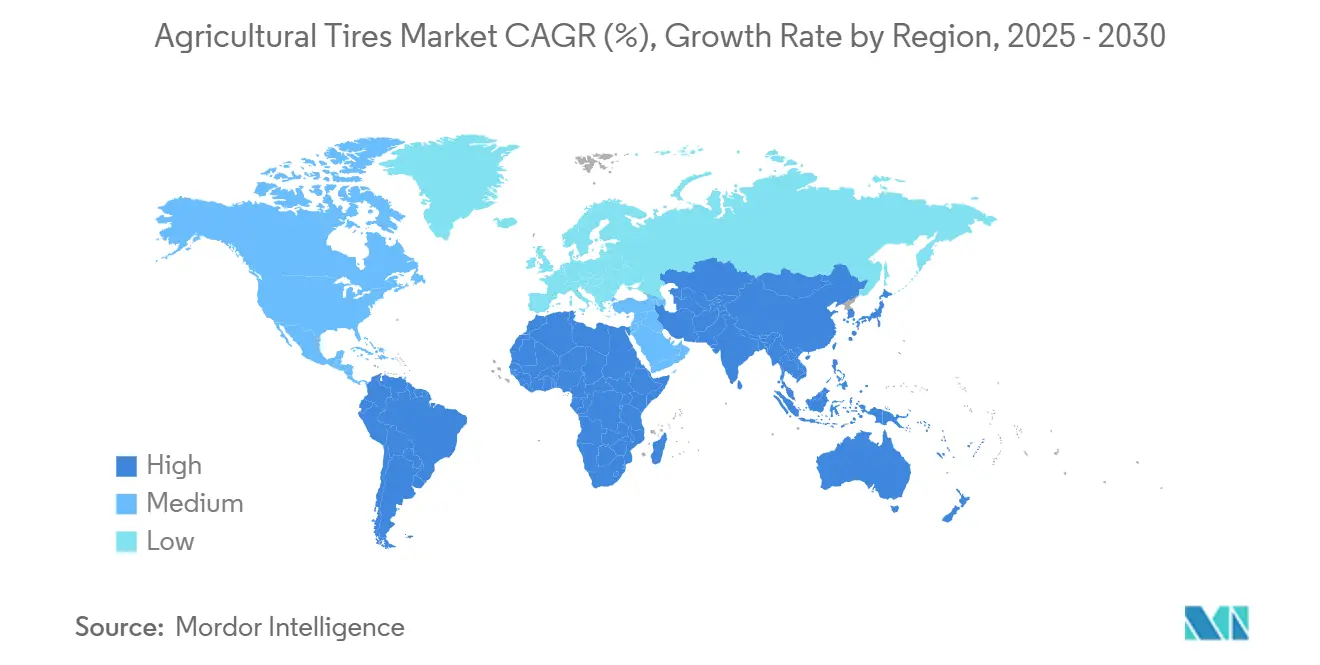
Competitive Landscape
The Agricultural Tires industry shows moderate concentration as global giants coexist with strong regional specialists. Bridgestone, Michelin, and Continental leverage extensive R-&-D and global footprint advantages, while BKT, Titan International, and Apollo capture share via cost-effective, application-specific lines. In February 2024, Titan International acquired Carlstar Group, broadening aftermarket channels and reinforcing supply to North American distributors[3]“Titan Acquires Carlstar Group,” Titan International, titan-intl.com .
Digitalization is a unifying theme: VF tire launches are increasingly paired with IoT-enabled monitoring that feeds machine-learning platforms for predictive maintenance. Continental’s ContiConnect Live retrofit kit exemplifies such offerings, providing tire-pressure and temperature data via cellular networks. Meanwhile, supply-chain risks have prompted vertical-integration moves, with Michelin investing in guayule plantations to secure bio-based rubber sources. Funding allocations exceeding for plant automation, as disclosed by Pirelli’s 2025 industrial plan, reveal an industry-wide pivot to smarter, leaner manufacturing.
White-space entrants span telematics startups and sustainable-material innovators, adding another competitive layer. Tire makers increasingly court OEM tractor brands through bespoke co-development programs, solidifying stickiness and raising switching costs. This collaboration-rich environment is expected to intensify the technological race that defines value creation in the Agricultural Tires market.
Agricultural Tires Industry Leaders
-
Michelin
-
Bridgestone Corporation (Firestone)
-
Titan International Inc. (Goodyear Tires)
-
BKT Tires
-
Continental AG
- *Disclaimer: Major Players sorted in no particular order
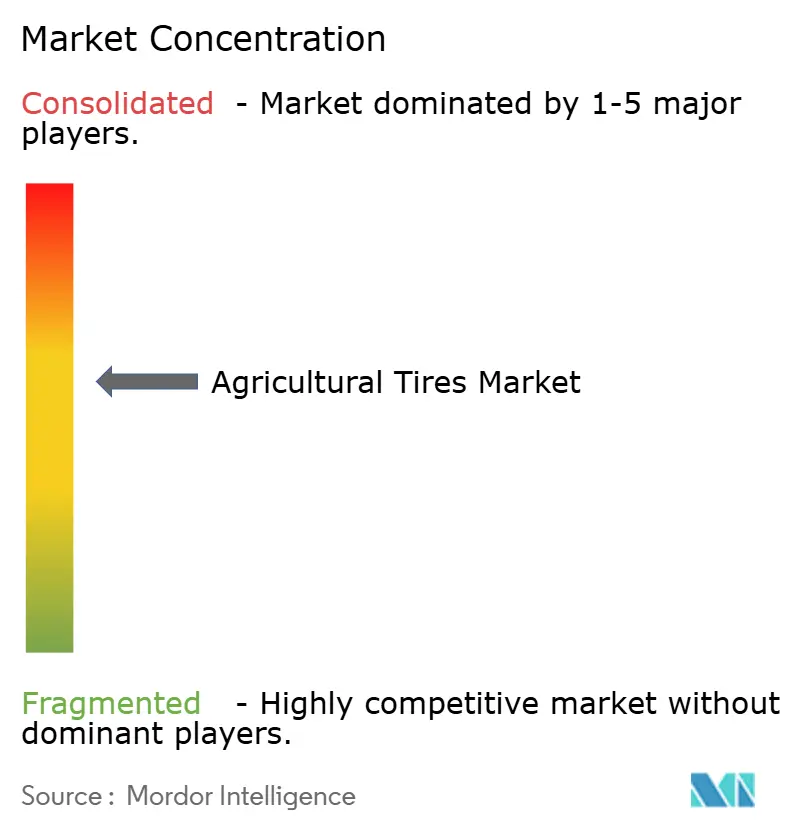


Recent Industry Developments
- March 2025: Apollo expanded its Vredestein Traxion range for CLAAS tractors, adding sizes optimized for the ARION series to enhance traction and durability.
- March 2025: Mitas introduced the Agriterra ULTRA trailer tire with reinforced carcass to lower heat build-up and heighten stability under heavy loads.
- January 2025: Yokohama launched the Alliance Agriflex+ 377 XT flotation tire embedding VF sidewalls and CFO technology, enabling 40% higher load at identical pressure and 55% extra capacity in cyclical operations.
Global Agricultural Tires Market Report Scope
An agricultural tire is a specialized tire designed for use in agricultural machinery and equipment, such as tractors, combines, and harvesters. These tires are built to withstand the unique demands of agricultural applications, providing traction, stability, and flotation on various terrains. They are designed with deep treads, reinforced sidewalls, and strong carcasses to handle heavy loads, reduce soil compaction, and improve overall performance in farming operations.
The agricultural tire market is segmented by sales channel type, application type, tire type, and geography. By sales channel type, the market is segmented as OEM and replacement/aftermarket. By application type, the market is segmented as tractors, combine harvesters, sprayers, trailers, loaders, and other application types. By tire type, the market is segmented into bias tires and radial tires. By geography, the market is segmented as North America, Europe, Asia-Pacific, and the rest of the World. The report offers the market sizes in value (USD) for all the mentioned segments.
| OEM |
| Replacement / Aftermarket |
| Tractors |
| Combine Harvesters |
| Sprayers |
| Trailers |
| Loaders & Telehandlers |
| Other Implements |
| Bias |
| Radial |
| IF / VF Radial |
| Less than 20 inch |
| 20 – 30 inch |
| 30 – 40 inch |
| More than 40 inch |
| Less than 30 HP |
| 30 – 70 HP |
| 71 – 150 HP |
| More than 150 HP |
| Standard Tires |
| CTIS-Ready / Smart Tires |
| North America | United States |
| Canada | |
| Rest of North America | |
| South America | Brazil |
| Argentina | |
| Rest of South America | |
| Europe | Germany |
| United Kingdom | |
| France | |
| Italy | |
| Spain | |
| Russia | |
| Rest of Europe | |
| Asia-Pacific | China |
| Japan | |
| India | |
| South Korea | |
| Australia | |
| Rest of Asia-Pacific | |
| Middle East and Africa | United Arab Emirates |
| Saudi Arabia | |
| Turkey | |
| Egypt | |
| South Africa | |
| Rest of Middle East and Africa |
| By Sales Channel | OEM | |
| Replacement / Aftermarket | ||
| By Application | Tractors | |
| Combine Harvesters | ||
| Sprayers | ||
| Trailers | ||
| Loaders & Telehandlers | ||
| Other Implements | ||
| By Tire Construction | Bias | |
| Radial | ||
| IF / VF Radial | ||
| By Rim-Size | Less than 20 inch | |
| 20 – 30 inch | ||
| 30 – 40 inch | ||
| More than 40 inch | ||
| By Equipment Horse-Power Class | Less than 30 HP | |
| 30 – 70 HP | ||
| 71 – 150 HP | ||
| More than 150 HP | ||
| By Inflation-Technology Compatibility | Standard Tires | |
| CTIS-Ready / Smart Tires | ||
| By Geography | North America | United States |
| Canada | ||
| Rest of North America | ||
| South America | Brazil | |
| Argentina | ||
| Rest of South America | ||
| Europe | Germany | |
| United Kingdom | ||
| France | ||
| Italy | ||
| Spain | ||
| Russia | ||
| Rest of Europe | ||
| Asia-Pacific | China | |
| Japan | ||
| India | ||
| South Korea | ||
| Australia | ||
| Rest of Asia-Pacific | ||
| Middle East and Africa | United Arab Emirates | |
| Saudi Arabia | ||
| Turkey | ||
| Egypt | ||
| South Africa | ||
| Rest of Middle East and Africa | ||


Key Questions Answered in the Report
How large is the Agricultural Tires market in 2025?
The Agricultural Tires market size is USD 8.61 billion in 2025.
What is the projected CAGR for Agricultural Tires through 2030?
The market is forecast to register a 5.95% CAGR between 2025 and 2030.
Which application category is expanding fastest?
Sprayers are the fastest-growing application, advancing at a 6.03% CAGR through 2030.
Which region is set to deliver the highest growth?
South America leads with a projected 6.21% CAGR over the forecast horizon.
Why are IF/VF tires gaining popularity?
IF/VF designs carry 20-40% more load at the same pressure, cutting fuel use and preserving soil, which raises yields by up to 4.31%.
What factors underpin aftermarket dominance?
Farmers’ tendency to maintain older equipment during high interest-rate cycles keeps replacement tire demand robust, sustaining 71.29% aftermarket share in 2024.
Page last updated on:
